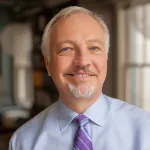 Photo by Molly DeCoudreaux
Photo by Molly DeCoudreaux
5 Questions for Matt Foreman
A year after the U.S. Supreme Court made marriage equality the law of the land, the LGBT community witnessed a day of unspeakable horror, as a gunman massacred forty-nine people and injured dozens at the Pulse nightclub in Orlando, Florida. As terrible as it was, the shooting was followed by proud displays of collective resilience and celebration. On June 24, President Obama designated the Stonewall Inn—a New York City gay bar that is widely considered to be the birthplace of the modern gay rights movement—as the first-ever national monument honoring LGBT rights.
PND recently spoke with Matt Foreman, senior program director at the Evelyn and Walter Haas, Jr. Fund, about the significance of these events. Foreman joined the fund in 2008, after serving as executive director of the National Gay and Lesbian Task Force, the Empire State Pride Agenda, and the New York City Gay and Lesbian Anti-Violence Project. At the Haas, Jr. Fund, he played a key role in the Civil Marriage Collaborative, a consortium of foundations that helped push marriage equality over the finish line.
PND: You have written about how the Civil Marriage Collaborative helped boost marriage equality by funding public education efforts “to change hearts and minds” and by supporting the movement’s efforts to develop a shared strategy. What were the advantages of using a funder collaborative? And were there any downsides?
Matt Foreman: The primary advantage of the CMC was that it enabled—and in some ways compelled—the marriage movement’s primary foundation funders to consistently align and focus their investments, both through and outside the CMC. The field and the funders jointly identified their priorities, which encouraged the LGBT movement to come together in supporting a bold, long-term vision for marriage equality.
As for downsides, there were some challenges, yes. At the highest level, creating strong funder collaboratives requires a lot of time and a willingness to compromise, more than it takes to go it alone. Although it sometimes makes the job harder, it also can lead to different, and better, outcomes. Another challenge was that the CMC served as a gatekeeper for how foundation dollars flowed to the field. While that allowed for more efficiency and consistency in supporting these efforts, it also frustrated some organizations that fell outside the CMC’s strategic priorities and thus didn’t get funding.
PND: What lessons learned from the campaign for marriage equality might be applied to grantmaking in support of other social justice causes?
MF: For me, the most important lesson was that foundations have a unique ability to get organizations to come together, develop plans to win, and then work together at multiple levels—from research to field work to litigation—to get over the finish line. Of course, that also requires foundations to be willing to take the risk of funding the game plan and playing hardball when groups deviate from it. Setbacks are inevitable when you’re working on making big, societal change, so it’s critical to learn from mistakes and be able to move forward.
After the historic marriage equality decision, we identified eleven lessons that we learned along the way and might be worth consideration among funders of other social justice movements. We’ve put together a report and a video about those lessons, which include the need to hire staff with social movement experience and to invest early in high-impact, multi-dimensional public education efforts that are data driven, thoroughly tested, and tailored to targeted communities and sectors.
—By Kyoko Uchida
